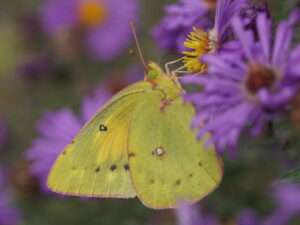I find it challenging to predict what’s harder: butterfly presence and abundance or the weather. However, considering that the weather directly impacts butterfly populations, I’d say butterflies win the title. Therefore, I was delighted to see a slight boom in Red Admirals (Vanessa atlanta) this June, as predicted. During a week-long stay at Camp Mitigwa, just west of Luther, Iowa, with a group of scouts, I observed clusters of dozens of Red Admirals throughout the camp. Now, let’s see if I can make another accurate prediction for July.

Colias eurytheme
While I won’t solely focus on the most prevalent species, it’s worth noting that if that were the case, I would spend each forecast talking about the Cabbage White (Pieris rapae). It’s likely the species most commonly seen in urban areas in Iowa, even if people don’t realize it. By analyzing recent survey data and historical records, I anticipate a strong population of Orange Sulphurs (Colias eurytheme) by late July.
These butterflies use ultraviolet patterns on their wings for courtship purposes. Though I can’t delve into the current understanding of the Orange Sulphur’s relationship with ultraviolet patterns within this forecast, I recommend looking it up—it’s a fascinating read. And if you’re thinking, “Wait, butterflies have UV patterns we can’t see?” you’re right—some butterflies and even certain plants possess them. Every November, I conduct a program on butterflies and blacklights, which I always find incredibly enjoyable. This year, in July, I’ll be participating in a Floral Fluorescence Night Walk. Exploring the entire UV spectrum and its role in plant/insect communication is truly captivating.

Papilio glaucus
In the middle of June, while attending a meeting here at Reiman Gardens, I caught sight of my first Tiger Swallowtail (Papilio glaucus) this year. It was an amusing moment because, as I sat quietly during the meeting, I suddenly exclaimed, “Tiger Swallowtail!” These butterflies are so large and distinctive that they are hard to miss and always a joy to behold. The end of July and the first part of August will be the best time to spot the largest population of Tiger Swallowtails. Speaking of Swallowtails (Papilio), I’d like to take a moment to address an important matter. Out of all the sites I’ve examined for historical records, there is only one county in Iowa that doesn’t have a single Swallowtail sighting for any of the four species typically found in the state. So, if you know someone living in Winnebago County, please ask them to keep an eye out for one and report their sighting somewhere—anywhere. If your friend in Winnebago doesn’t have a preferred site to upload sightings, they should consider checking out insectsofiowa.org. This site is convenient as it doesn’t require an account, making the process quick and easy.
This month is an opportune time to search for cute Silver-Spotted Skipper (Epargyreus clarus) caterpillars if you know the location of some Locust trees. However, please note that you’ll have to wait until the first week of August to witness the peak of Silver-Spotted Skipper butterflies. The behavior of these caterpillars is fascinating—they construct yurt-like structures to live in when they’re not feeding. The early instar caterpillars chew a “C”-shaped piece of leaf along the edge, fold it over, and secure it with silk. As they grow larger, they continue creating bigger structures using the same technique until they become so large that they only need silk lines to hold clusters of full leaves together.

Epargyreus-Clarus
I often hear people remark that they don’t see as many butterflies as they did when they were younger. My usual response is to ask whether they spend as much time in the same places as they used to. Most people admit they don’t, and that’s a significant factor. For the few who answer “yes,” I inquire about how those spaces have changed over the years. This question usually initiates a conversation about how changes in habitat and surrounding areas affect butterfly abundance and diversity. It’s worth noting that insect populations can fluctuate drastically from year to year due to various factors, further complicating butterfly population forecasting. People often remember boom and bust years more vividly. To gain a better understanding of changes in butterfly populations or any insects, we need more individuals to participate in annual insect surveys. You don’t need to go it alone, nor do you have to be a professional entomologist to participate—there are numerous programs and apps available that make it possible for anyone to get involved.
Until next time,
Nathan Brockman
Director of Entomology, Reiman Gardens

